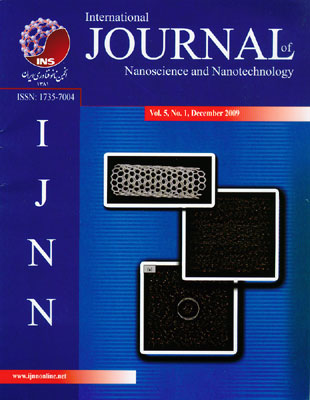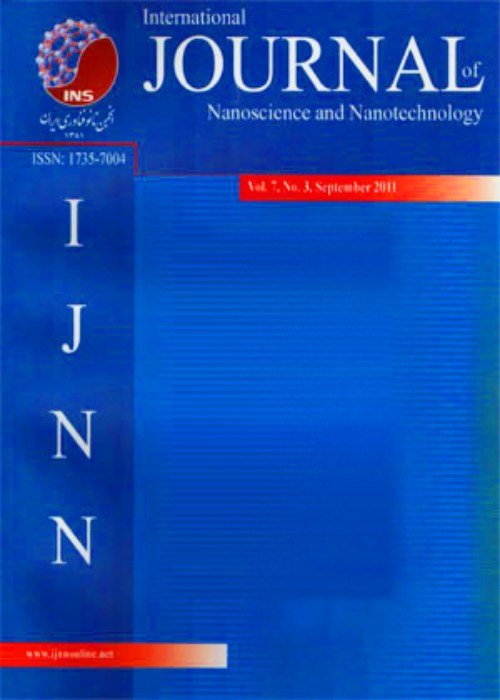فهرست مطالب

International Journal Of Nanoscience and Nanotechnology
Volume:5 Issue: 1, Autumn 2009
- تاریخ انتشار: 1388/05/10
- تعداد عناوین: 7
-
-
Pages 3-8The Ultra-nanocrystalline diamond (UNCD) was synthesized by the detonation of a high explosive mixture in water confinement. The presence of a diamond phase was revealed by X-ray diffraction (XRD) and transmission electron microscopy (TEM). X-ray line broadening (XRLB) was used to evaluate the peak profiles of diamond nanoparticles and their corresponding average crystallite sizes. The micro structure has investigated by high resolution transmission electron microscopy. The results indicate that the optimum of Cyclotrimethylenetrinitramine addition on TNT is 60% and the size of nanodiamond particle was about 5nm.Keywords: Cyclotrimethylenetrinitramine, TNT, Ultra dispersed nanodiamond, wet media
-
Pages 9-18Carbon nanotube, a new structure of carbon element, is composed of graphene sheets rolled into closed concentric cylinders with diameter of the order of nanometers and length of micrometers. Liquid arc discharge was used for fabrication of carbon nanotubes, and subsequently a modified acid treatment method applied for purification stage. A statistical design of experimental (DOE) (Taguchi method with L16 orthogonal array robust (OA) design and Qualitek-4 software) was implemented in this work to optimize the process. Voltage, current, catalyst type and plasma were considered as process parameters to be optimized. As the result of taguchi analysis in this study, voltage and catalyst were the most influencing parameters on the yield production of carbon nanotubes (~4.121 mg min-1 purred CNTs). The maximum product yield of CNTs were obtained at voltage of 25, LiCl (o.25 M) as a salt in solution, Ni/Mo as a co-catalyst and the catalyst ratio of. The scanning electron microscopy (SEM) and transmission electron microscopy (TEM) were utilized to study the morphology of these carbon nanotubes.Keywords: liquid arc discharge, Taguchi method, Design of experiment, Carbon nanotube, Synthesis, Optimization
-
Pages 19-24The aim of this research is to calculate the elastic constants and Bulk modulus of Cu-20 wt% Ni random Nanoalloy. The molecular dynamics simulation technique was used to calculate the mechanical properties in NPT ensemble. The interaction between atoms as well as cohesive energy in the Nanoalloy modeled systems was calculated by Morse et al. two body potential. Also the temperature of the system was controlled by Nose-Hoover thermostat and the pressure was controlled by using the Berendsen barostat. The effects of the temperature and Nanoalloy size on the elastics constants as well as bulk modulus were studied. The obtained results show that the variation in the size and temperature of Cu, Ni as well as Cu-Ni Nano cluster causes some changes on the mechanical properties. Moreover, the effect of Ni concentration on the mechanical properties of Cu-Ni random Nanoalloy was investigated.Keywords: Cu, Ni Nanoalloy, Bulk Modulus, Elastic constants, Molecular dynamics simulation
-
Pages 25-34A new folate-conjugated gold nanoparticle (AuNP) has been designed to selectively target the folate receptor that is overexpressed on the surface of tumoral cells. For this purpose, we made 4-aminothiophenol, as a bifunctional linker to react with HAuCl4 in the presence of sodium borohydride and it was binded to the AuNP surface through its thiol group. Then, we conjugated amino-terminated nanoparticles to folic acid with an amide-linkage formation. Finally, we evaluated the specific interaction between the folic acid and AuNP by the corresponding observed characteristic bands in the UV-vis and FTIR spectra. Transmission electron microscopic (TEM) images reveal the spherical AuNPs formation induced by the bifunctional linker. Powder X-ray diffraction (XRD) patterns confirmed the metallic face-centered cubic (FCC) lattice structure with (111), (200), (220), and (311) crystal planes. We estimated the average size of the conjugated nanoparticles to be about 5 nm by TEM and XRD. The Elemental analysis and atomic absorption showed 59 % organic molecules on the surfaceof AuNPs
-
Pages 35-42This work describes the optical and structure properties of nickel sulfide and cobalt sulfide nanoparticles in ZSM-5 zeolite. The samples were obtained by sulfidation of the Ni2+ and Co2+ ion-exchange ZSM-5 zeolites in a Na2S solution at room temperature. The optical properties of the samples were studied by UV-visible spectroscopy. Their crystalline structure and morphology were studied by X-ray diffraction and scanning electron microscopy. Specific surface area and infrared spectroscopy results reveal that nanoparticles could grow on the surface area of ZSM-5 zeolites. Absorption peaks at higher energy than the fundamental adsorption edge of bulk nickle sulfide and cobalt sulfide indicate quantum confinement effect in nanoparticles as a consequence of their small size. The absorption spectra show that the optical band gap varies in the range of 3.91-4.72 eV.Keywords: Nanocomposites, Nanostructures, ZSM, 5 zeolite, X-ray diffraction, Semiconductors, Infrared spectroscopy
-
Pages 43-52UV-induced grafting technique was used as a flexible method for surface modification of Polysulfone (PSf) ultrafiltration (UF) membranes in order to prepare hydrophilic nanofiltration (NF) membranes. Flat sheet Polysulfone (PSf) ultrafiltration membranes were prepared via phase inversion method. N-methylene-2-pyrrolidone (NMP) and polyethylene glycol (PEG) of three different molecular weights (MW) (200, 400 and 600 Da) were used as solvent and the polymeric additive in casting solution respectively. Effect of PEG MW and grafting conditions including monomer concentration and irradiation time on membrane performance as pure water flux (PWF), salts rejection and PEG retention at 300 kPa operation pressure was studied. Several surface analytical techniques including FTIR-ATR, SEM and AFM were used to characterize the changes resulting from modification. The results showed PWF drastically decreases and salt rejection increases where monomer concentration and irradiation time are increased which corresponds to a decrease in pore size from 3.42 to 2.62 nm. According to AFM photographs the RMS roughness of this membrane is 2.3 nm which is in NF range.Keywords: Polysulfone, Phase Inversion, Nanofiltration membrane, Polyethylene glycol, UV graft, Acrylic Acid
-
Pages 53-62The overall aim of this study is to calculate some water properties in the single wall carbon naotubes (SWCNT) and compare them to the bulk water properties to investigate the deviation of water properties inside the SWCNT from those in the bulk. Here some physical and transport properties of water molecules in the single wall carbon nanotube were reported by performing molecular dynamics (MD) simulation. Radial and axial density; hydrogen bond numbering; hydrogen bond distribution and diffusivity of water molecules inside the SWCNT were calculated. Results have good agreements with other researcher results. These calculations show that molecular dynamics simulation would be a reasonable method to analyze the properties of the new nanoscale systems.Keywords: Molecular dynamics simulation, Gromacs software, Einstein equation, diffusion coefficient


